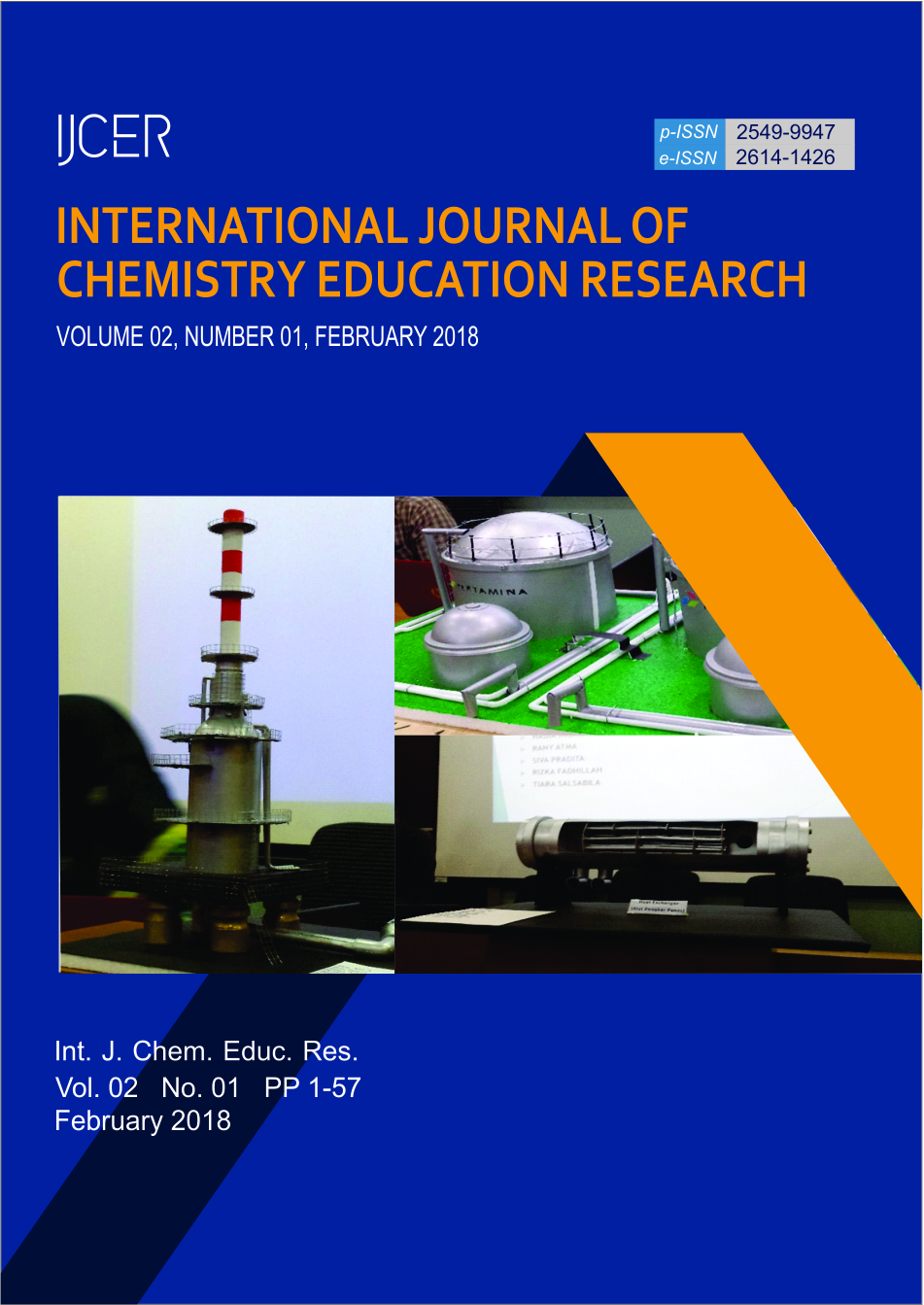Main Article Content
Abstract
ABSTRACT: This study aims to examine the characteristics and quality of chemical enrichment books based on ethnosciences as a source of science literacy learners. The research method used is Research and Development. Data collection using questionnaire method. Data analysis is done quantitatively and qualitatively. The result of research is in the form of chemical enrichment book based on ethnoscience with characteristics: (1) A5 print media, (2) raised 4 Javanese cultural themes especially Yogyakarta area consisting of Batik, Wayang Kulit, Merapi, and Dagger themes, (3) the theme in general, the transformation of science from indigenous science to scientific science, and the renewal steps that can be made based on the existing environmental or social facts in the theme, (4) developed by containing affective, cognitive, and
psychomotor domains. Assessment is performed using an assessment instrument that refers to the instrument B1 of the Center for Curriculum and Bookkeeping. Assessment by material experts, media experts, cultural experts, chemistry teachers, and students' responses were 83.33%, 90.9%, 60%, 84.30%, and 90%, respectively, with Good category (B), Very Good (SB), Enough (C), Very Good (SB), and Good (B), thus this chemical enrichment book deserves to be a source of science literacy by students
Keywords: development, enrichment book, ethnoscience, javanese culture, literacy science
Received: 10 February 2018, 16 February 2018, Accepted: 24 February 2018
Article Details
Author retain copyright and grant the journal right of first publication with the simultaneously licenced under A Creative Commons Attribution (CC-By-SA) 4.0 License that allows others to share the work with an acknowledgment of the worsk's authorship and initial publication in this journal.
References
- Depdiknas, Model Mata Pelajaran Muatan Lokal (Depdiknas, Jakarta, 2006).
- Kementrian Pendidikan dan Kebudayaan, Dokumen Kurikulum 2013 (Kemendikbud, Jakarta, 2012).
- T. Sastrawijaya, “Proses Belajar Mengajar Kimia†(P2LPTK Dirgen Dikti Depdikbud, Jakarta, 1988).
- D. Nugraheni, S. Mulyani and S. R. D. Ariani, JPK, 3, 2, 34 – 41, 2013.
- I. W. Suastra, JPP IKIP Negeri Singaraja, 3, 1, 377 – 396, 2005.
- A. Nisa’, Sudarmin and Samini, USEJ, 4, 3, 1049 – 1056, 2015.
- U. Toharudin, S. Hendrawati, H. A. Rustaman, (Humaniora, Bandung, 201 1).
- Pusat Kurikulum dan Perbukuan. Pedoman Penulisan Buku Nonteks Pelajaran (DepartemenPendidikan Nasional, Jakarta, 2008).
- E. Matanga, and S. Jerie, JSDA, 13, 4, 369 – 409, 2011.
- H. S. A. Putra, “Ethnoscience dan Etnoteknologiâ€, (Kongres Kebudayaan, Bukittinggi, 2003).
- PISA 2012 Results: Ready to Learn (Volume III) Student’s Engagement, Drive and Self Beliefs (OECD Publishing, 2013).
- S. Nasution, “Berbagai Pendekatan dalam Proses Belajar Mengajar†(PT Bumi Aksara, Jakarta, 2008).
- N. S. Sukmadinata, Metode Penelitian Pengembangan, (PT Remaja Rosdakarya, Bandung, 2011 ).
References
Depdiknas, Model Mata Pelajaran Muatan Lokal (Depdiknas, Jakarta, 2006).
Kementrian Pendidikan dan Kebudayaan, Dokumen Kurikulum 2013 (Kemendikbud, Jakarta, 2012).
T. Sastrawijaya, “Proses Belajar Mengajar Kimia†(P2LPTK Dirgen Dikti Depdikbud, Jakarta, 1988).
D. Nugraheni, S. Mulyani and S. R. D. Ariani, JPK, 3, 2, 34 – 41, 2013.
I. W. Suastra, JPP IKIP Negeri Singaraja, 3, 1, 377 – 396, 2005.
A. Nisa’, Sudarmin and Samini, USEJ, 4, 3, 1049 – 1056, 2015.
U. Toharudin, S. Hendrawati, H. A. Rustaman, (Humaniora, Bandung, 201 1).
Pusat Kurikulum dan Perbukuan. Pedoman Penulisan Buku Nonteks Pelajaran (DepartemenPendidikan Nasional, Jakarta, 2008).
E. Matanga, and S. Jerie, JSDA, 13, 4, 369 – 409, 2011.
H. S. A. Putra, “Ethnoscience dan Etnoteknologiâ€, (Kongres Kebudayaan, Bukittinggi, 2003).
PISA 2012 Results: Ready to Learn (Volume III) Student’s Engagement, Drive and Self Beliefs (OECD Publishing, 2013).
S. Nasution, “Berbagai Pendekatan dalam Proses Belajar Mengajar†(PT Bumi Aksara, Jakarta, 2008).
N. S. Sukmadinata, Metode Penelitian Pengembangan, (PT Remaja Rosdakarya, Bandung, 2011 ).




